The streets of Warsaw were involved in the project “I am Ukrainka” – a series of six portraits of Ukrainian female migrant workers on posters and 12 city lights. City lights are places where usually people view attractive females in advertising images. In contrast to these Photoshop-processed photographic images, the “I am Ukrainka” images were hand-painted by Ukrainian artists in a different manner. The fragment from a 200-hryvnia bill with the portrait of Lesia Ukrainka, a prominent Ukrainian poet, writer, translator and polyglot forms the background of each poster in this series. Such a background encourages us to think about the interweaving of economic, cultural and national dimensions into modern capitalist systems.
In the large cities of Eastern Europe, such as Warsaw or Prague, it has become commonplace for physical work (both male and female, such as construction or cleaning) to be done by migrants from eastern neighboring countries. One symptom of this pattern is that the working class is often marked by national signs and symbols. The phenomenon has become a norm. Sometimes “normalization” deprives us of any critical outlook. People begin to fail to see these workers in any capacity, so by displaying their portraits on city lights we aim to attract attention to them – their faces repositioned from invisibility to an atypical place – from reality to the place of visual representation.
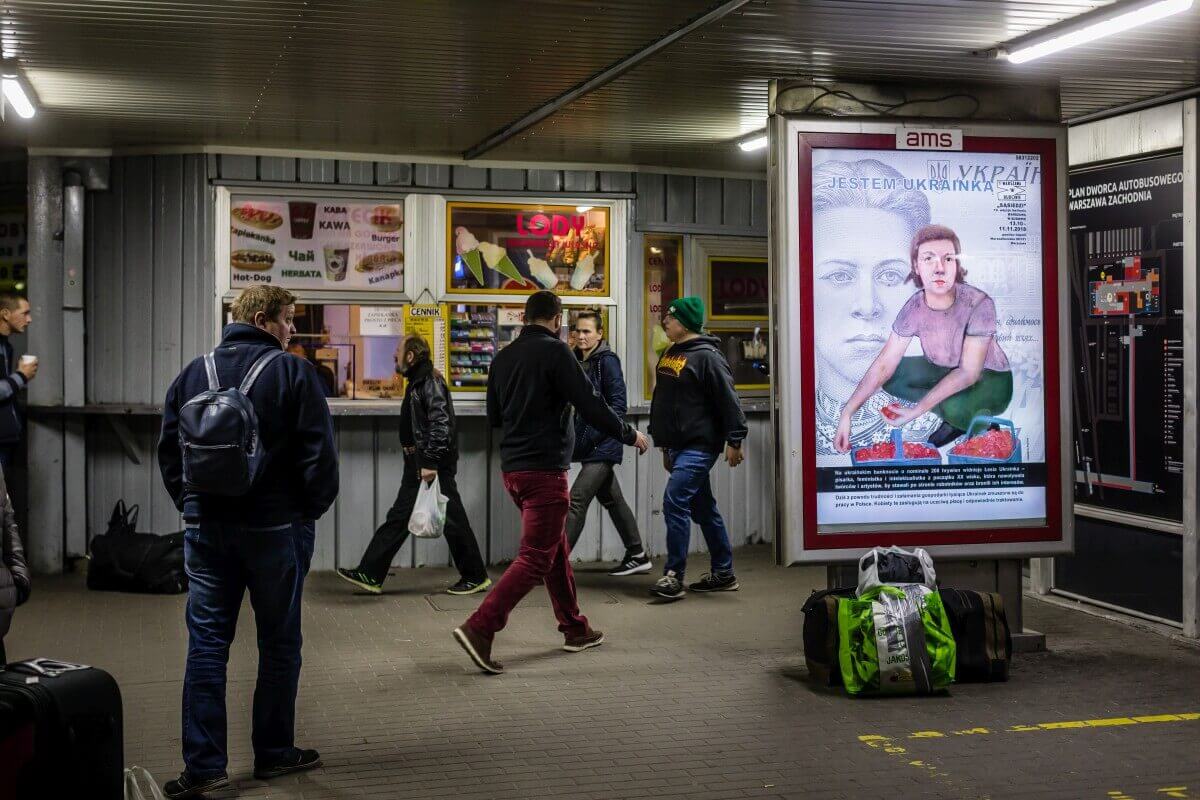
Today in Ukraine the salaries of workers is often so small, that many people cannot even afford to pay for housing and communal services. At the industries and enterprises where workers try to demand higher salaries, they may hear from their employers, who often represent oligarchs, the same answer: “If you don’t like it here, go to Poland to work!” And so they do go, oftentimes only to fill gaps in the workforce elsewhere by taking up the cheapest forms of labor in the European Union. So we see how the system works: forced labor migration becomes profitable for both markets.
In Ukraine many people with high levels of education have also found themselves in a hopeless position – teachers, doctors, etc. In the post-Soviet context, many salaries of the professions that were paid by the state have not been adjusted to reflect changes in cost of living. In the E.U. they can easily find work involving physical labor, which helps them to survive, yet at the same time cuts off their professional growth. As we know, female workers across many sectors remain lower paid in nearly every country throughout the world. Migrant labor is even lower paid. There are also special types of labor, still marked as “female,” or “pink collar” – usually involving cleaning and caring – which are socially and economically marginalized, as it is still largely considered “normal” when women do this kind of work at home for free, as it is the woman who is expected to do it. Such stereotypes are still very strong in Ukrainian society. So Ukrainian women are considered to be excellent housekeepers.
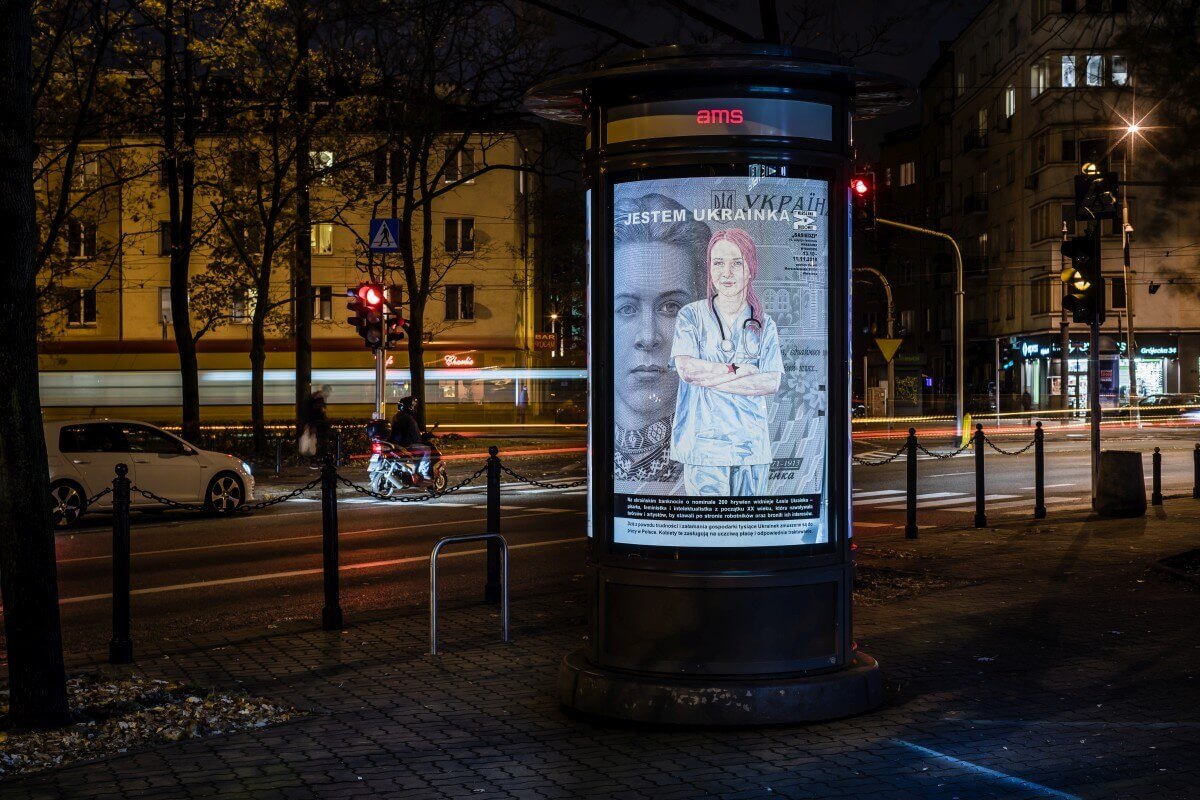
Ukrainian migrant workers go to Poland and to other Western countries – in fact, this has been the case for awhile now, at least since the 1990s. They receive payment for this work, often paying into the tax and pension systems only temporarily, from which they will not benefit from later. They have become the shadow of European emancipated women, who climb the career ladder by refusing exhausting domestic work; yet, they are only able to do so by employing migrant women to clean their houses and to take care of old and sick relatives. So, in a way, to be an emancipated woman is a privilege in the world, while many other women continue to perform the activities associated with the female subordinate position in a patriarchal symbolic order, not withstanding the technical achievements that help us in our everyday life. We see how the contemporary capitalist system, despite high levels of technological advancement, still reproduces the most brutal forms of exploitation and social division.
It is often assumed that all ideas of female emancipation came from the West and then only later influenced East European and post-Soviet countries. Yet there is a more transnational history that is multidirectional. The feminist agenda, labeled as such, has taken different forms, yet has always been extremely important for Ukraine, until now. As early as the 19th century Ukraine had Lesia Ukrainka, an author and activist who clearly articulated and defended distinct feminist and socialist positions. Today those central components of her views are almost completely forgotten; instead, she plays the role of an Ukranian cultural icon. Her portrait on the posters “I am Ukrainka,” borrowed from its printing on the 200 Ukrainian Hryvnia banknote calls us to think critically about her ideas, like the full potential of female laborers, being reduced to simple transactions and unthinking exchanges. Herself an emancipated and educated woman, Lesia Ukrainka stood on the side of workers. She attributed creativity to workers too, but only if they were on the side of fairly representing people and their labor, rather than their wealthy exploiters. Responding to this thesis of Lesia Ukrainka, we, four Ukrainian artists, have created these portraits in solidarity with our working countrywomen.
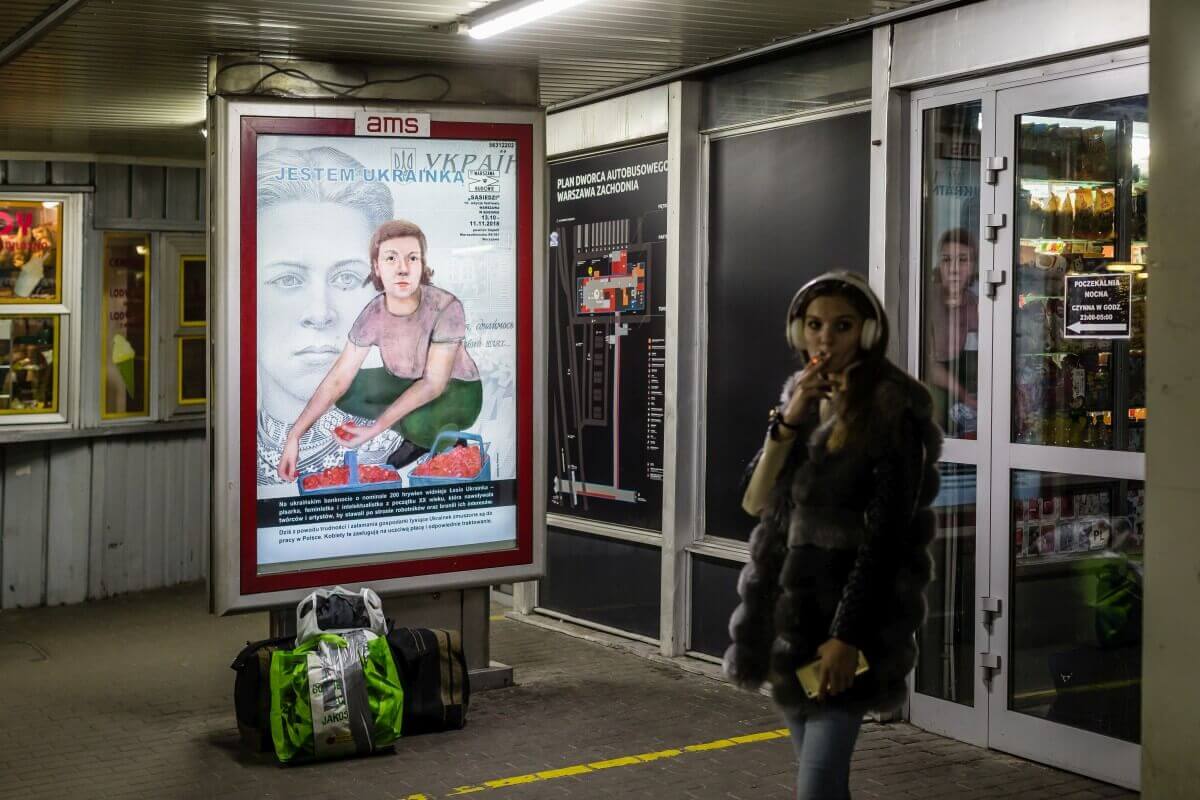
The “I am Ukrainka” campaign attempts to view labor from another perspective. Is it possible to stop reproducing the hierarchies which look down on people who do physical labor? Can we stop dividing people into different groups: one suitable for physical labor, and the other reserved for intellectual work and control, thereby recognizing the right of the first to intellectual activity, and the ability to share less attractive work? Might we start to appreciate and to share the labor of women, who provide our basic needs – food and cleanliness? The status of these women and the work they do are the beginning of a debate on modern forms of the capitalist economy and gender policy. Our posters “I am Ukrainka,” placed in public spaces, ensure that these women are visible within the symbolic field.
While assembling the exhibition in Cepelia the invited cleaning company consisted mostly of Ukrainian women. They did their work in a parallel reality and none of the artworks had any impact on their position or activities. It is likely that most of those women among us who work the hardest have had no opportunity to visit our exhibition, or to reflect on art.
For this reason, “I am Ukrainka” is placed on the streets –to take a step towards them.
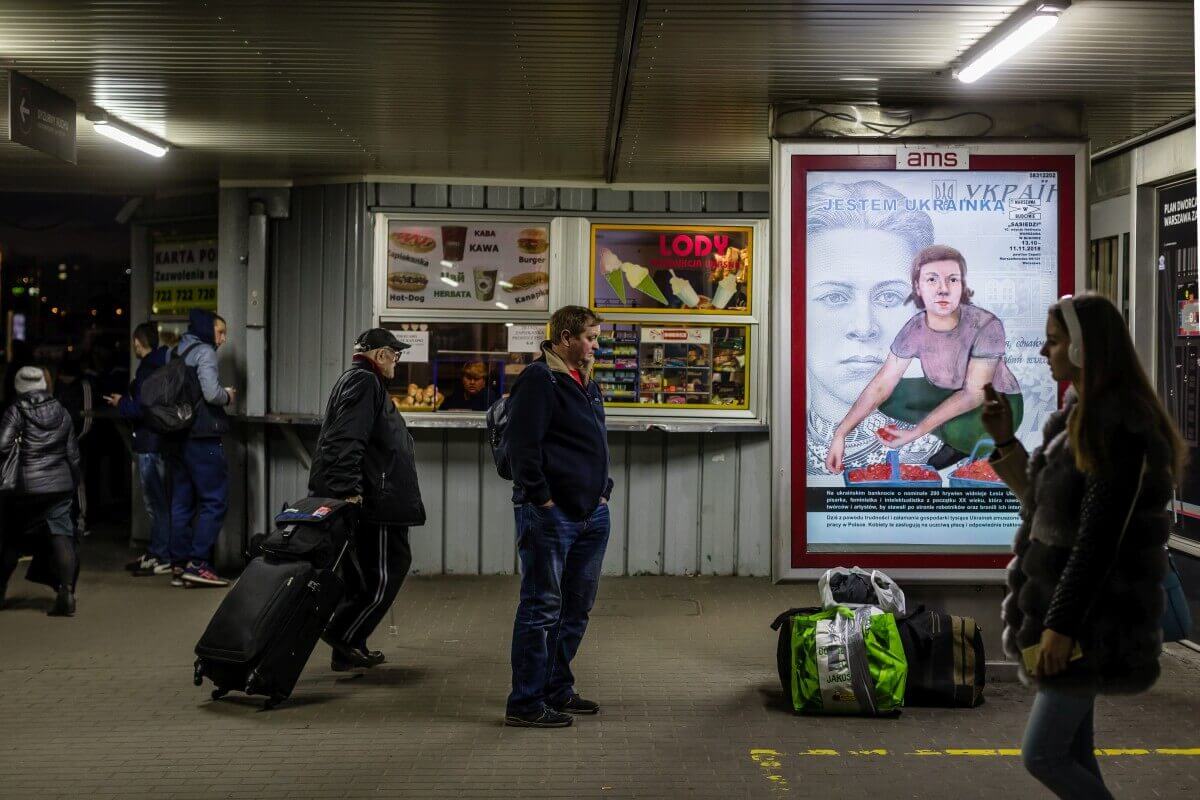
***
Over the past week, the images from the poster-campaign “I am Ukrainka” (Eng transl. “I am a Ukrainian”) provoked a great deal of discussion on facebook and throughout media in Ukraine. Reports on all sides focused on the hate attack that took place against the curator of the project. A cycle of blame ensued, in which opponents of the project claimed that the posters, which feature colorful paintings of contemporary working class women over a black-and-white picture of the iconic 19th century literary figure Lesia Ukrainka, were a humiliation to Ukrainian women; they claimed that the images fix stereotypes of Poles against Ukrainians. These critics completely ignored the calls for solidarity for fair labor practices that the curator intended the posters to represent. Their shaming statements instead showed disrespect for those women who work physically, sometimes in precarious or dangerous working conditions, in a general unwillingness to identify with members of the working class, and the right to fair labor. It was claimed that these women should not be represented in public space. Do they not deserve visibility as members of the public?
The fact that Ukraine is for the moment the poorest country in Europe, and one of the poorest in the world, is the primary reason why people are forced to migrate for work, and are ignored by many from the middle classes in both the new country of immigration, and at home. Idealism serves to blind many to realities, and along with them the positive, empowering traits of these migrant women in the working classes. Rather, some would prefer to relegate themselves to a narrowly defined vision of what makes all Ukrainian women strong, successful, and beautiful, failing to achieve more powerful insights into what this really means, especially with regard to solving critical economic issues faced by migrant women that affect all classes. As citizens belonging to the poorest country in Europe, many of these individuals are also misled by the capitalist ideology of success, which creates the conditions by which some can more easily choose to despise those who have experienced economic difficulties. Instead, the text on the poster says that these women deserve fair pay, and a sense of self-worth and dignity. Even feminism, in the various forms in which it exists in Ukraine today, fails in the sense that where one can observe a lot of enthusiasm for the idea of women’s success, there is silence when it comes to solidarity across class divides.
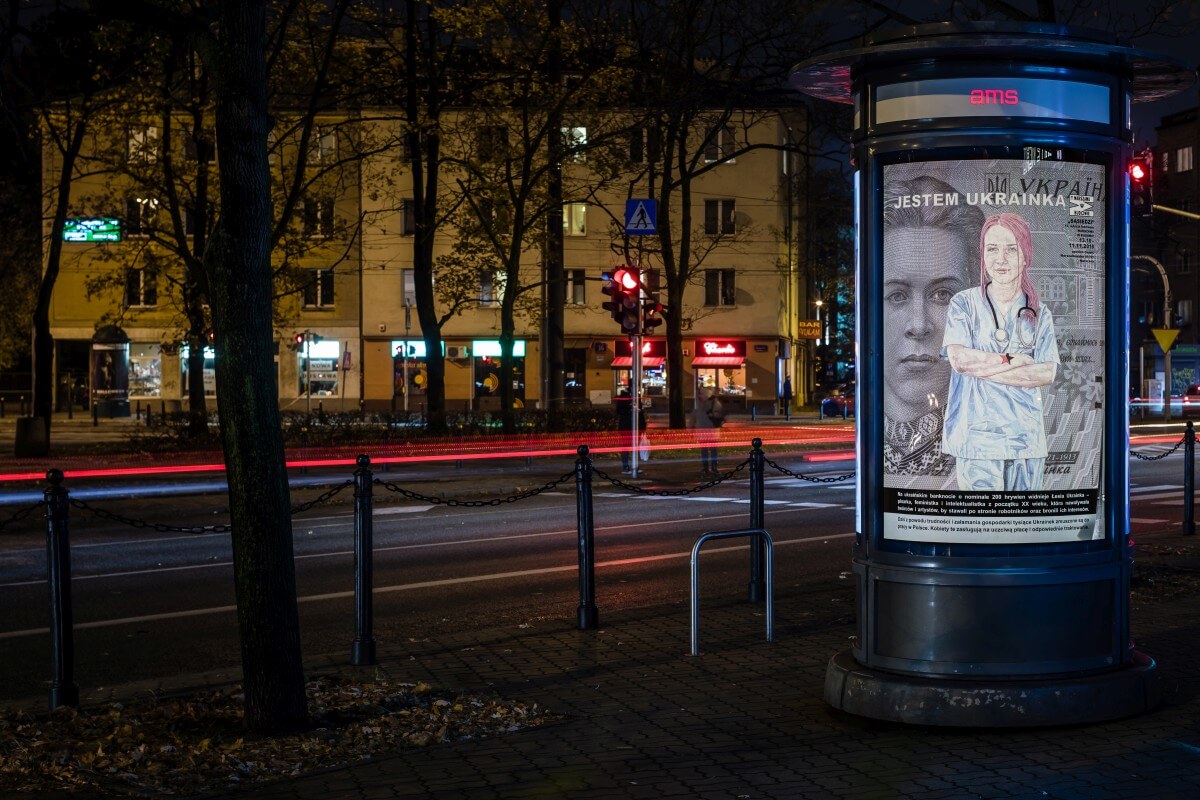
***
Originator and curator: Oksana Briukhovetska
Authors of portraits: Oksana Briukhovetska, Kseniya Hnylytska, Valentyna Petrova, Davyd Chychkan
2018, digital prints, posters.
![Political Critique [DISCONTINUED]](http://politicalcritique.org/wp-content/uploads/2015/09/Political-Critique-LOGO.png)
![Political Critique [DISCONTINUED]](http://politicalcritique.org/wp-content/uploads/2015/09/Political-Critique-LOGO-2.png)